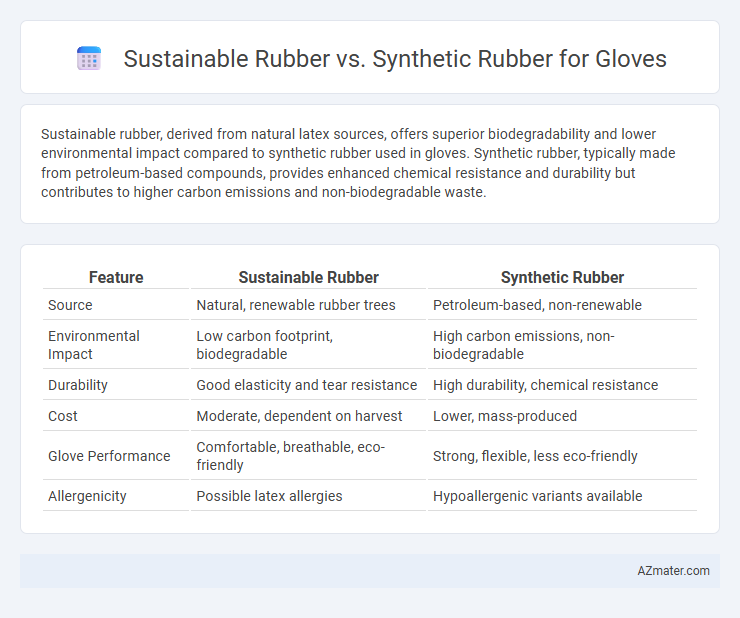Sustainable rubber, derived from natural latex sources, offers superior biodegradability and lower environmental impact compared to synthetic rubber used in gloves. Synthetic rubber, typically made from petroleum-based compounds, provides enhanced chemical resistance and durability but contributes to higher carbon emissions and non-biodegradable waste.
Table of Comparison
| Feature | Sustainable Rubber | Synthetic Rubber |
|---|---|---|
| Source | Natural, renewable rubber trees | Petroleum-based, non-renewable |
| Environmental Impact | Low carbon footprint, biodegradable | High carbon emissions, non-biodegradable |
| Durability | Good elasticity and tear resistance | High durability, chemical resistance |
| Cost | Moderate, dependent on harvest | Lower, mass-produced |
| Glove Performance | Comfortable, breathable, eco-friendly | Strong, flexible, less eco-friendly |
| Allergenicity | Possible latex allergies | Hypoallergenic variants available |
Introduction to Rubber Types in Glove Manufacturing
Sustainable rubber, derived from natural rubber trees, offers biodegradability and reduced environmental impact compared to synthetic rubber, which is produced from petrochemical sources. In glove manufacturing, sustainable rubber ensures high elasticity, durability, and comfort, making it ideal for medical and industrial applications. Synthetic rubber provides enhanced chemical resistance and consistent quality, but often lacks the eco-friendly benefits of sustainable alternatives.
Overview of Sustainable (Natural) Rubber
Sustainable rubber, derived from natural latex harvested from Hevea brasiliensis trees, offers an eco-friendly alternative with biodegradability and lower carbon footprint compared to synthetic rubber made from petrochemicals. Natural rubber provides superior elasticity, tensile strength, and puncture resistance essential for durable gloves, while supporting sustainable forestry practices and biodiversity conservation. Certified sustainable rubber ensures traceability and reduced environmental impact through responsible plantation management and reduced chemical usage.
Understanding Synthetic Rubber for Gloves
Synthetic rubber, primarily made from petrochemical sources, offers consistent quality and high durability essential for glove manufacturing in medical and industrial applications. Its resistance to chemicals, oils, and extreme temperatures makes synthetic rubber gloves highly reliable for various protective uses. Advances in polymer technology have enhanced synthetic rubber's elasticity and tensile strength, ensuring better fit and comfort for prolonged wear.
Environmental Impact: Sustainable vs Synthetic Rubber
Sustainable rubber, derived from responsibly managed rubber tree plantations, significantly reduces deforestation and biodiversity loss compared to synthetic rubber, which is produced from non-renewable petroleum-based resources. The biodegradability of sustainable rubber lessens long-term environmental pollution, whereas synthetic rubber generates persistent microplastics and greenhouse gas emissions throughout its lifecycle. Choosing sustainable rubber for gloves supports eco-friendly manufacturing practices and lowers carbon footprints relative to synthetic alternatives.
Performance and Durability Comparison
Sustainable rubber gloves, derived from natural latex, offer superior elasticity and biodegradability compared to synthetic rubber gloves made from nitrile or neoprene, which excel in chemical and puncture resistance. Performance-wise, sustainable rubber provides a better fit and tactile sensitivity ideal for medical and laboratory applications, while synthetic rubber delivers enhanced durability under harsh conditions and longer shelf life. Durability tests show synthetic gloves resist oils, solvents, and abrasion better, making them suitable for industrial use, whereas sustainable rubber gloves perform excellently in environments requiring flexibility and eco-friendliness.
Production Costs and Economic Implications
Sustainable rubber gloves, derived from natural latex, generally incur higher initial production costs due to eco-friendly harvesting and processing techniques, whereas synthetic rubber gloves, made from petrochemical-based materials like nitrile or neoprene, benefit from lower raw material expenses and scalable manufacturing. Economic implications favor synthetic rubber in mass production because of consistent supply and price stability, while sustainable rubber supports long-term market demand by appealing to environmentally conscious consumers and potentially reducing regulatory risks. Investment in sustainable rubber glove production may result in higher upfront costs but can yield competitive advantages through brand differentiation and compliance with emerging environmental standards.
Health and Allergen Considerations
Sustainable rubber gloves, derived from natural latex sourced through eco-friendly harvesting, offer superior biodegradability and reduced chemical exposure compared to synthetic gloves, which are typically made from petrochemical-based materials like nitrile or neoprene. Natural latex gloves provide excellent tactile sensitivity and comfort but can trigger allergic reactions due to the presence of proteins linked to latex allergy, necessitating thorough allergen management in healthcare settings. Synthetic rubber gloves minimize allergenic risks and chemical sensitivity, making them preferable for individuals with latex allergies, though they may lack the biodegradability and certain ergonomic advantages of sustainable natural rubber alternatives.
Biodegradability and End-of-Life Options
Sustainable rubber gloves, derived from natural latex, exhibit superior biodegradability compared to synthetic rubber gloves made from petrochemicals, breaking down more efficiently in composting environments. Biodegradable natural rubber enables more eco-friendly end-of-life options such as industrial composting or soil biodegradation, reducing landfill impact. Synthetic rubber gloves typically require energy-intensive recycling or incineration processes, highlighting sustainability challenges in waste management and environmental persistence.
Market Trends and Consumer Preferences
The global market for sustainable rubber gloves is rapidly expanding due to increasing consumer awareness of environmental impact and demand for eco-friendly healthcare products. Sustainable rubber, derived from natural latex, offers biodegradability and reduced carbon footprint compared to synthetic rubber, which is primarily petroleum-based and less environmentally friendly. Consumer preferences are shifting towards gloves with certifications such as FSC or FSC-Certified Natural Rubber, driving manufacturers to adopt sustainable sourcing and production practices to capture market share.
Future Innovations in Rubber Glove Materials
Future innovations in rubber glove materials emphasize sustainable rubber derived from Hevea brasiliensis trees, offering renewable and biodegradable properties that reduce environmental impact compared to petroleum-based synthetic rubber. Advances in bio-based polymers and enhanced processing techniques improve durability, flexibility, and allergenic safety of sustainable rubber gloves, making them competitive alternatives to traditional synthetic variants such as nitrile and neoprene. Research is focused on hybrid composites combining natural latex with synthetic elastomers to optimize performance while minimizing carbon footprint and promoting circular economy principles in glove manufacturing.

Infographic: Sustainable rubber vs Synthetic rubber for Glove
 azmater.com
azmater.com